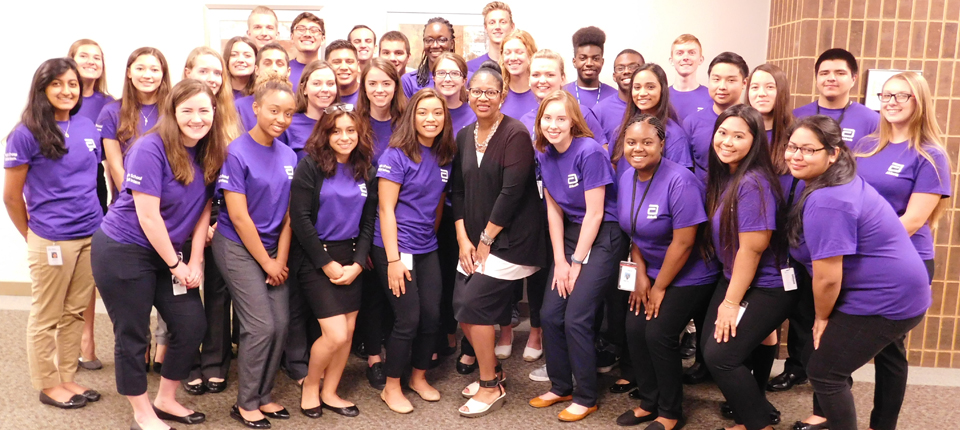
When Investing In The Future Gets Personal
Abbott’s Top Engineer Receives Advocating Women in Engineering Award; Shares Why She Recruits and Fosters STEM Talent.
Nov. 01, 2017
- Copy Link
- Share on X
- Share on Facebook
- Share on Linkedin
Corlis Murray's grandfather farmed cotton in Louisiana for most of his life. Though he had just an eighth-grade education, he was quick as ever with numbers – something he passed down to his children and grandchildren.
When his 17-year-old granddaughter, Corlis, mentioned to him in passing one day that she planned to become an engineer, he paused.
"Honey," he said. "Why on earth would you want to drive a train for a living?"
Corlis wasn’t talking about trains, of course. She was talking about building things, making things. Everything that exists, after all, she’ll tell you, has been engineered.
More than 40 years later and today Corlis is the top engineer at Fortune 150 global healthcare company Abbott. On Oct. 27, 2017, she accepted the Advocating Women in Engineering Award from the Society of Women Engineers for her work on the company's STEM education and recruitment initiatives. The investment in "demystifying" science and engineering for young women and minorities is an investment in the innovators who will create the next generation of breakthrough healthcare products that improve and save lives, she says.
A similar investment was made in her at just 17 when IBM chose her out of her inner-city Dallas class to complete a summer internship. Quitting her $1.76-an-hour job at Jack in the Box may have seemed like a big deal at the time – but the decision changed the trajectory of her life.
"That summer demystified engineering for me," Corlis said. "It's the first time I truly understood what it meant to be an engineer and the impact you could have on people's lives."
Her mentor was an African-American man who taught her primarily how to troubleshoot technical problems on mainframe systems – the brains at the time of a computer's operating system. But he also looked like her, and his example reinforced for her that she, too, could be an engineer if she wanted to.
She wanted to.
The road was not always easy. There were times she was passed up for promotions, only to learn the reason was her ethnicity, or her gender.
"I was just stubborn enough to push past those obstacles," Corlis said. "I wasn't going to let who I was, my gender, or my ZIP code dictate where I ended up in life."
This past year, the Oscar-nominated film Hidden Figures – which tells the story of the African-American women mathematicians who helped successfully launch John Glenn into space as the first American to orbit around the earth – stirred up a nationwide celebration of those who have been "firsts" in their fields.
"It was inspiring to see how many young girls watched the film and the inspiration they, in turn, took away from it," Corlis said. "But it was also somewhat disheartening for me, because there is still, even today, so much work to be done."
Only about one out of every seven engineers today is a woman. Less than 4 percent of engineering degrees are awarded to African Americans. And the gap grows the higher you get – for example, just 3 percent of master's degrees in science and engineering go to minority women along with less than 1 percent of doctoral degrees.
A big reason for that is girls don't consider STEM careers viable options – or don't even know what they're all about, because they're seldom exposed to them. Almost 60 percent of girls say they never consider a career in STEM and just 10 percent of girls say their parents would encourage them to think about a career in engineering. With a strong belief that it's important to reach future STEM talent early, six years ago, Corlis worked with Abbott to start a high school internship program.
"You can tell how passionate she is about our success," said Evon Lopez, who landed her first engineering internship at Abbott at just 15 years old. "She makes us want to succeed, and she doesn’t take it easy on us. These are hard projects. We're expected at a really young age to learn how to work as professionals and to speak up with our ideas."
Almost 90 students have participated in the program to date and 97 percent go on to pursue a STEM degree or end up in a STEM career. Though there are no admission guidelines on gender or race, based on the schools the students come from, typically about two-thirds of interns are young women and about 60 percent are minorities.
Corlis is also involved in other groups advocating for women and minorities in STEM, including Women Leaders of Abbott, the Black Business Network, and Abbott’s other STEM initiatives around the world, which have reached more than 200,000 participants since their inception.
"If I let the odds dictate my future, I certainly wouldn't be doing the work I do today," Corlis said. "It's an honor to work at a company dedicated to both investing in the innovators of tomorrow and inspiring those from diverse backgrounds to both discover and pursue their dreams."
For the latest on Abbott’s life-changing technology, get updates directly in your inbox.